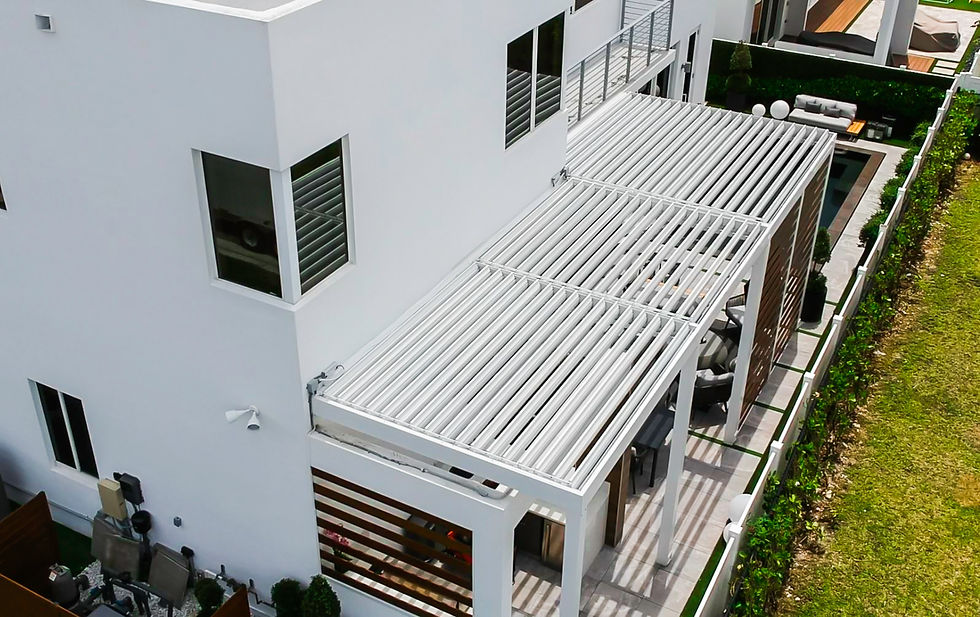Designing Pergolas for Florida's Climate: Balancing Style and Functionality
- tonydiaz0809
- May 2, 2024
- 2 min read

Florida's diverse climate, characterized by intense sun, occasional rain, and high humidity, poses unique challenges and opportunities for outdoor structures like pergolas. Designing pergolas for this environment requires a careful balance between style and functionality to ensure they not only enhance the aesthetics of outdoor spaces but also provide practical shade and comfort. In this article, we explore the key considerations and strategies for designing pergolas that are well-suited to Florida's climate.
Understanding Florida's Climate Challenges
Before delving into design aspects, it's crucial to understand the climate factors that influence pergola design in Florida:
Intense Sun: Florida experiences abundant sunshine throughout the year, necessitating effective shading solutions to prevent overheating and sun exposure.
Rain and Humidity: While rain showers are common, especially during the summer months, high humidity levels can impact the durability and maintenance of outdoor structures.
Wind and Storms: Florida is prone to occasional strong winds and tropical storms, requiring sturdy construction to withstand such weather conditions.
Key Design Considerations
Material Selection: Opt for materials that can withstand Florida's climate, such as weather-resistant woods like cedar or durable options like aluminum or vinyl. Consider UV-resistant finishes to protect against sun damage.
Shade Coverage: Design the pergola with sufficient shade coverage using slatted roof panels, retractable canopies, or fabric shades that can be adjusted as needed.
Ventilation: Incorporate elements like open sides, lattice panels, or pergola designs that promote airflow to prevent humidity buildup and enhance comfort.
Structural Integrity: Ensure the pergola is structurally sound to withstand strong winds and storms. Use reinforced posts, sturdy beams, and secure anchoring methods.
Water Management: Plan for proper drainage to prevent water pooling on the pergola roof or around its base. Consider gutters, downspouts, or sloped roof designs.
Low Maintenance: Choose materials and finishes that require minimal upkeep in Florida's humid environment. Regular cleaning and inspections for mold or mildew are essential.
Style and Aesthetics: Blend style with functionality by selecting pergola designs that complement your outdoor space's overall look. Consider decorative elements like climbing plants, lighting, or built-in seating.
Integrating Technology and Comfort Features
To enhance the functionality of pergolas in Florida, consider integrating technology and comfort features:
Smart Controls: Incorporate motorized shades or adjustable louvers that can be controlled remotely via smartphone apps or home automation systems.
Cooling Systems: Install misting systems, fans, or integrated cooling solutions to combat heat and humidity, making outdoor areas more comfortable.
Lighting: Add ambient and task lighting options to the pergola for evening use, enhancing both safety and aesthetics.
Privacy Screens: Incorporate retractable screens or privacy panels to create secluded spaces within the pergola as needed.
Designing pergolas for Florida's climate requires a thoughtful approach that balances style with practicality. By considering climate challenges, selecting appropriate materials, ensuring structural integrity, and integrating comfort features, pergolas can become versatile outdoor spaces that provide shade, comfort, and aesthetic appeal year-round. Whether for residential patios, poolside areas, or commercial outdoor spaces, well-designed pergolas enhance the Florida outdoor living experience.
Arte Patio is a leader in the region in the development and production of custom pergolas, approved by the FLBC. Contact us.




Comments